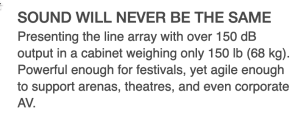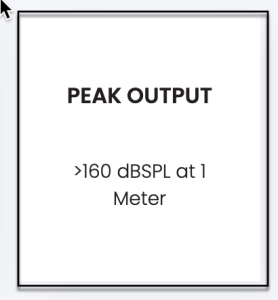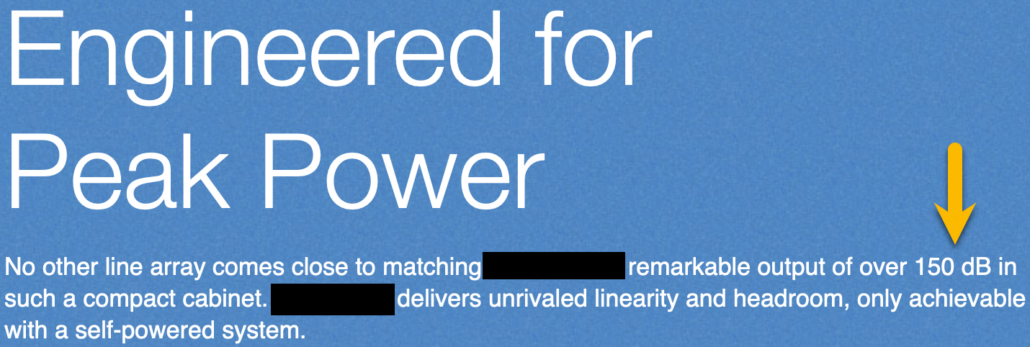Thoughts on AES75, M-Noise, and “Maximum Linear Peak SPL”
Some have asked my opinion of AES75. I have compiled some thoughts in a document that can be shared with anyone interested.
I am aware of the AES75 Standard and have reviewed it from both a technical and practical perspective. I have some concerns which I will list below. First, I am fine with much of the content of AES75. We’ve been doing it for years. There are three aspects of the Standard that are problematic. These are
1. Exclusive use of the M-Noise stimulus
2. The use of coherence for establishing a loudspeaker rating
3. The measurement/specification of “maximum linear peak SPL” which I will call MLPS in this document.
I have numbered the following concerns to aid anyone that would like to discuss or disagree with my assertions. First, there is a sentence from each point to summarize my main concern. For those interested I have elaborated on each through the remainder of the document. Please use the reference number when you email me. You may use the contact form of this website.
1. Signal peaks have little to do with loudness.
2. Loudspeaker and amplifier ratings are already exaggerated.
3. One-sample-wide signal peaks are not found in music or speech.
4. Sound pressure level, when used to imply loudness, requires consideration of time.
5. The spectrum of an M-Noise impulse is white, not shaped.
6. The MLPS gives a very high rating for non-loud signal events.
7. The simple power equation is only accurate for continuous signals into resistive loads.
8. The standard is dominated by a single manufacturer.
9. The loudspeaker buying decision will be highly influenced by a meaningless specification (MLPS).
10. The standard should allow any appropriate noise type, not just M-Noise.
11. The MLPS rating as described in the standard is highly dependent on the amplifier, measurement platform, and SPL meter.
12. The calculation of coherence is platform-dependent and the reading is affected by multiple variables.
13. Filtering a waveform changes its crest factor.
14. What genre of music does M-Noise emulate?
15. In practice a loudspeaker will not be used with an amplifier large enough to produce its MLPS.
16. The measurement of signal peaks requires special instrumentation and has poor repeatability.
And now, the details…
1. It has been understood (and well-documented) for a century that instantaneous peak “anything” is a mostly meaningless metric. The automotive sound and hi fi industries invented this decades ago to get larger numbers to market their products. Things got so bad with amplifiers that the Federal Trade Commission had to intervene. Welders and vacuum cleaners are marketed with peak ratings to this day, making it nearly impossible to compare products based on their published specs. Bottom line: peak ratings are misleading.
2. The professional audio industry has already been corrupted by “large number” specifications. Several consultants have told me that they don’t bother considering loudspeakers for their projects that can’t “do” 140 dB. This has resulted in many loudspeaker manufacturers claiming “140 dB” output, even if their actual max level is 10 – 15 dB lower. Few marketeers even consider where this number actually comes from – they only care that it is “big” and they will invent ways to spec it lest they lose market share. It’s hard to blame them. I can envision “150 dBZpk” being quite the sales tool. Of course the “dbZpk” will be dropped in most references, leaving only the number.
From the Standard:
AES75 max linear sound levels: 126 dBZ, 144 dBZpk, 120 dBA,
at an RMS input level of 31 dBV (35,5 V)
We now have a way to rate a “126 dB” box at “144 dB.” Which of the “max linear sound levels” do you suppose will be used to market this device? Below is from a loudspeaker manufacturer’s website.

Of course that has to be a peak level, but it is not specified as “dB anything.” Here’s another one from a competitor to the above. Once a company starts “selling” with peak SPL, the others are pressured to follow suit. As you can seen now even “140 dB” is not competitive.


3. The impulses embedded in the M-noise waveform bear little resemblance to anything found in nature. In fact, if such events were present in actual program, we would investigate to find the source of the problem – probably sample drops in the digital domain. We certainly wouldn’t base a rating on them. By comparison even the most dynamic music has peaks that have much longer duration than M-Noise peaks (just zoom-in with a wave editor), yet even these real-world peaks still have little to do with the perceived loudness of the waveform. Why do they need a rating? As a system designer why would I care?
4. Power consumption (and generation) requires consideration of at least 4 parameters – voltage, current, a phase angle, and time. The phase angle becomes zero if the load is resistive, which of course loudspeakers are not (that’s a different discussion). The current is usually assumed to track the voltage, and it usually does in a properly loaded amplifier. What we measure is the voltage, making most “power” ratings “voltage ratings in disguise.” Loudspeaker power ratings are conversions, not direct measurements.
I applaud AES75 for the use of voltage and dBV instead of power ratings, but it is just as wrong to use the waveform peak for the voltage (or pressure) as it is for power if the voltage is going to converted to power. Reducing the time metric to near zero (e.g. an impulse) produces a very low RMS voltage (and very little power), yet these “ratings” yield the largest numbers. See the problem?
5. The spectrum shape of M-Noise is defined in the Standard. It is similar to (but not the same as) existing noise spectra used to find the maximum RMS voltage that a loudspeaker can handle. However, the pulse events used to determine the peak SPL have a white spectrum. This weights the (small) energy content toward the high frequency end of the spectrum. This peak voltage is a very high number. If a sound system designer (or a system design program) divides this voltage into 1/N-octave bands (per the published M-Noise spectrum) to find the peak SPL in specific frequency bands, the low frequency SPL will be grossly exaggerated since the peak voltage energy is concentrated at high frequency. This high frequency dominance is apparent from a simple listening test. The MLPS rating specifies a Z-weighting, yet it is inherently weighted by the signal type.
6. The perceived level of sound has this same time-dependence. Reduce the time duration to zero and an event will not be perceived as loud, yet with AES75 these events yield the largest rating. Will anyone plug their ears when listening to M-Noise because of the loud peaks? Why would anyone buy an expensive, specialized meter (with Class 1 microphone) to capture them and write a Standard to rate them? They are irrelevant. The peak events in M-Noise would not heat a cup of tea.
7. Again, kudos to the AES working group for the use of voltage and dBV in the Standard. It’s the correct way, but unfortunately many (most) in the audio community aren’t used to thinking that way, having been inundated with power ratings for decades. What they “get” is watts, so the first question after being confronted with a voltage rating is “How many watts is that?” Hmmmm, here’s a formula:
W = E2/R
As the Standard points out, the peak voltage of these impulse events approaches 400 V. I would expect the bulk of sound reinforcement loudspeakers in the marketplace “handle” these peaks. Doing the “math” (improperly) results in 20 kW into 8 ohms. Wait? Our box is 4 ohms? That’s 40 kW. Look, there’s a dip to 2 ohms in the impedance plot. That’s 80 kW! See the problem? It’s coming.
While that seems ridiculous, we already have “10 kW” amplifiers in the marketplace running on 2400 W circuits. Yes, they are making power (sarcasm). I agree with the need for using multiple metrics and signal types to rate products, but none of them should be allowed to violate the Law of Conservation of Energy.
If we have a MLPS rating for a loudspeaker, why not a maximum linear peak power rating for the amplifier used to measure it (sarcasm)? Amplifier ratings are about to get a lot bigger.
8. One manufacturer is allowed to invent a metric by which all competing devices are rated by Standard (rhetorical question)?
9. What is the harm, so long as other ratings are included? Consumers (including some sound system designers) generally don’t think about this stuff very deeply. They will just look for the largest number. So, at the end of the day all anyone will care about is the MLPS as there will be the assumption that it places the most demand on the loudspeaker. Everything else should be easy, right? This is improper thinking. It is at best bad physics and at worse it is deceptive.
So, now the “140 dB” problem is “150 dB” and the required power is 20 kW. These imaginary numbers are based on non-loud events that produce almost no heat in a voice coil and come from an amplifier producing almost no power. See the problem? At least in the 1970’s they used the peak voltage of a sine wave to rate the products. Now we’ve Standardized a rating using the peak voltage of a narrow impulse. So, if a larger rating can’t be achieved with higher amplitude, let’s reduce the duration to near zero (sarcasm). Progress?
10. AES75 includes RMS ratings too. I agree with that section of the Standard. That part could have been written around several noise spectra. We have good choices that are already Standards. Why are we Standardizing a “branded” noise that must be downloaded from a branded website? Maybe next we will have C-Noise from Community or D-Noise from Danley (sarcasm). The M-Noise website touts the use of the MLPS and the need to use M-Noise to properly measure it. This is marketed as a “real world” SPL measurement. Yes, it says that. The intent is clearly to produce a larger maximum SPL rating for the loudspeaker than traditional methods. Perusers of the Internet will find the M-Noise site and think they have the whole story on loudspeaker specifications and SPL, with MLPS being the most important one.
11. The conditions for selecting the amplifier and analyzer described in Annex B are complex. Assuring that the measurement system meets the conditions of the Standard is a research project in and of itself. The Standard admits that failure to observe these conditions can (and will) affect the outcome of the test. Given the number of conditions required for an “accurate” measurement, no two labs will likely produce the same peak rating for the same DUT.
12. The calculation of “coherence” is measurement platform-dependent. It is not a deterministic metric like the sound pressure level or the loudspeaker impedance. Coherence is necessitated when music or speech are used for transfer function measurements. It answers the question “What are the chances that the input signal produced the output signal?” This keeps you from trying to EQ the subs during a flute solo. Coherence is only necessary when using music or speech as the program source for measuring the transfer function. It is a “live sound” function.
The use of coherence is inappropriate for producing a specification. Loudspeakers are often purchased based on a few dB difference in ratings, yet the large number of measurement system conditions and variables in AES75 may produce these differences on their own. When producing specifications, one should not “twiddle with the settings” if they don’t get the expected outcome, especially based on an indication as loosely defined as coherence, yet this is what is described in Annex B.
13. The Standard states that the M-Noise program can be filtered to be appropriate for the device-under-test. Yet, filtering a waveform changes its crest factor. This is another reason why signal peaks should be ignored when establishing the maximum RMS input voltage to a loudspeaker and the maximum SPL from a loudspeaker.
14. The M-Noise website claims that M-Noise is more like music than pink noise. Maybe so, but what music? Rock, jazz, classical? How can one make such a claim? Other Standard noise spectra (e.g. IEC-268-1) clearly describe how the noise spectrum was determined. It involved the averaging of many music types. They didn’t just add impulses to the program until a target crest factor was reached and then claim that this emulates music.
15. The amplifier required to measure the MLPS is massive. The required voltage rails are only attainable by a few very expensive sound reinforcement amplifiers, probably running in bridged mode. No one will buy one of these so that their loudspeaker can produce its MLPS. Even if they did, they will likely eventually destroy the loudspeaker by allowing the RMS voltage to exceed what the loudspeaker can handle. If a limiter is used to protect the loudspeaker (highly advisable) then why buy such a large, expensive amplifier to begin with? Why publish a specification that will not be achievable in actual use?
In practice, the peak SPL will be determined by the amplifier, not the loudspeaker. One can easily calculate it from the loudspeaker’s sensitivity and the amplifier’s maximum voltage, as determined from its power rating. The peak rating in AES75 as determined with an over-sized test amplifier is meaningless. Its only possible use is to market the loudspeaker to a technically naive buyer. That statement is not meant to disparage the buyer in any way. It is not their responsibility to fully understand loudspeaker ratings. But, they should be able to trust engineers and standards to provide meaningful ratings that represent the actual performance of a product. The credibility of our industry is at stake.
16. The MLPS measurement is made with a digital meter set on peak mode. Such readings are dubious at best, especially for very short acoustic events. One can’t know which event was measured over the duration of the test, and whether the measurement is repeatable for that event. Loudspeakers have both mass and inertia, and cannot reproduce Dirac-like impulses. Yet the peak level test does not consider the wave shape, only the peak amplitude. Given the number of and sensitivity of the variables, it is unlikely that the same test results will be achieved by different measurement systems and measurement labs. We are left with a large, unverifiable rating that has no purpose when selecting an amplifier or designing a sound system.
If one does indeed wish to know the MLPS we have a time-proven method. The use of wavelets at a 1/n-octave frequency interval, along with an oscilloscope, will produce the MLPS as a function of frequency. Don Keele has championed this method since 2004. The same test can be used for amplifiers and loudspeakers.
I could go on, but I don’t see a “maximum linear peak SPL” rating as described in AES75 as progress for our industry. It is just a reinvention of the same mistakes made 50+ years ago, this time on steroids.
For these reasons, Pro Sound Testing will continue to perform RMS testing as described in AES75 using traditional, standardized noise spectra. It will not perform the “maximum linear peak SPL” test nor specify the metric in our loudspeaker data.
Pat Brown
President
Pro Sound Testing, Inc.
Synergetic Audio Concepts, Inc.
